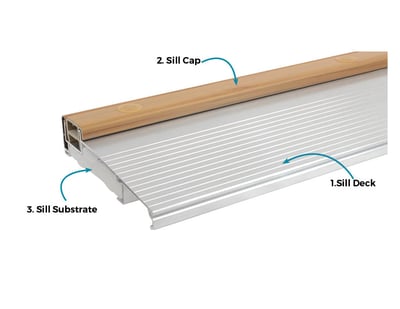Drafts, leaks, and difficult door operation can all be signs of a troublesome door sill but can be fixed with a few simple adjustments.
Not sure which adjustment needs to be made? Don’t worry! We’ll guide you through the anatomy of a door sill, the types of sills available, and the importance of a properly adjusted sill to help keep your home safe and protected all year long.
The Anatomy of a Door Sill
A sill is a door component located at the bottom of your exterior door frame. Think of a sill as a gateway which helps prevent water and air from entering your home. The main parts of a sill typically include a sill deck, a sill cap, and the substrate.
The sill deck (1) is composed of a metal material and provides a smoothed walking surface into the home. The sill cap (2), which sits on top the sill deck meets your door bottom and helps to keep your home sealed. Substrates (3) can be manufactured of either wood or synthetic materials. While wood substrates tend to wear and rot over time, synthetic substrates are durable and last for years.

TYPES OF SILLS
There are three major types of sills:
-
fixed sills
-
adjustable sills
-
self-adjusting sills
A fixed sill has a sill cap which doesn’t move and cannot be adjusted. Typically, caulk is used to secure this sill to your frame during installation.
The adjustable sill has screws located within the sill cap, allowing you to modify the height of your sill. Adjusting your sill cap is important when sealing your home and can remedy some common issues such as drafts, leaks, and door bottom interference. This takes both time and manual effort, but can be effective when done properly.
Last, there is the self-adjusting sill. The patented Z-Articulating Cap Sill™ compensates for imperfections in your door system and prevents leaks and drafts under your door. This is a caulk-free system and offers a worry-free solution to many homeowner problems.
Make Sure Your Sill is Properly Sealed
Having a properly installed door sill provides many benefits to your home. Not only does your sill keep air and water outside, it also keeps your home’s conditioned air inside, saving you money on monthly heating and cooling bills.
Keeping your door sill properly adjusted and adding appropriate weatherseals to your door system can provide a large benefit when protecting your home. Many homeowners face issues like leaks and cold air drafts inside their homes and do not realize how their door sill plays a critical part in these problems. Don’t become a victim of poor weather sealing and adjustment this season—seal your home properly.
How to Adjust Your Sill
If your sill is adjustable, you will be able to modify it in case you notice drafts or leaks beneath your door. Adjusting your sill will allow you to create a more perfect seal,protecting your home from the elements and maintaining a more comfortable indoor temperature without straining your HVAC system.
To adjust your sill, start by removing any corner pads or cap plugs that are installed. Then, adjust the screws to the desired height.
If you’re having trouble closing your door, you may need to lower the sill, but if you notice light under your door, you’ll need to raise it. Open and close your door a few times to test the seal, then reinstall your cap plugs and corner pads.
For full video instructions on how to adjust your sill, click HERE.
TIP: If you have a Z-Articulating Cap Sill, you won't have to make these manual adjustments, because your sill automatically adjusts itself every time you open and close your door!
